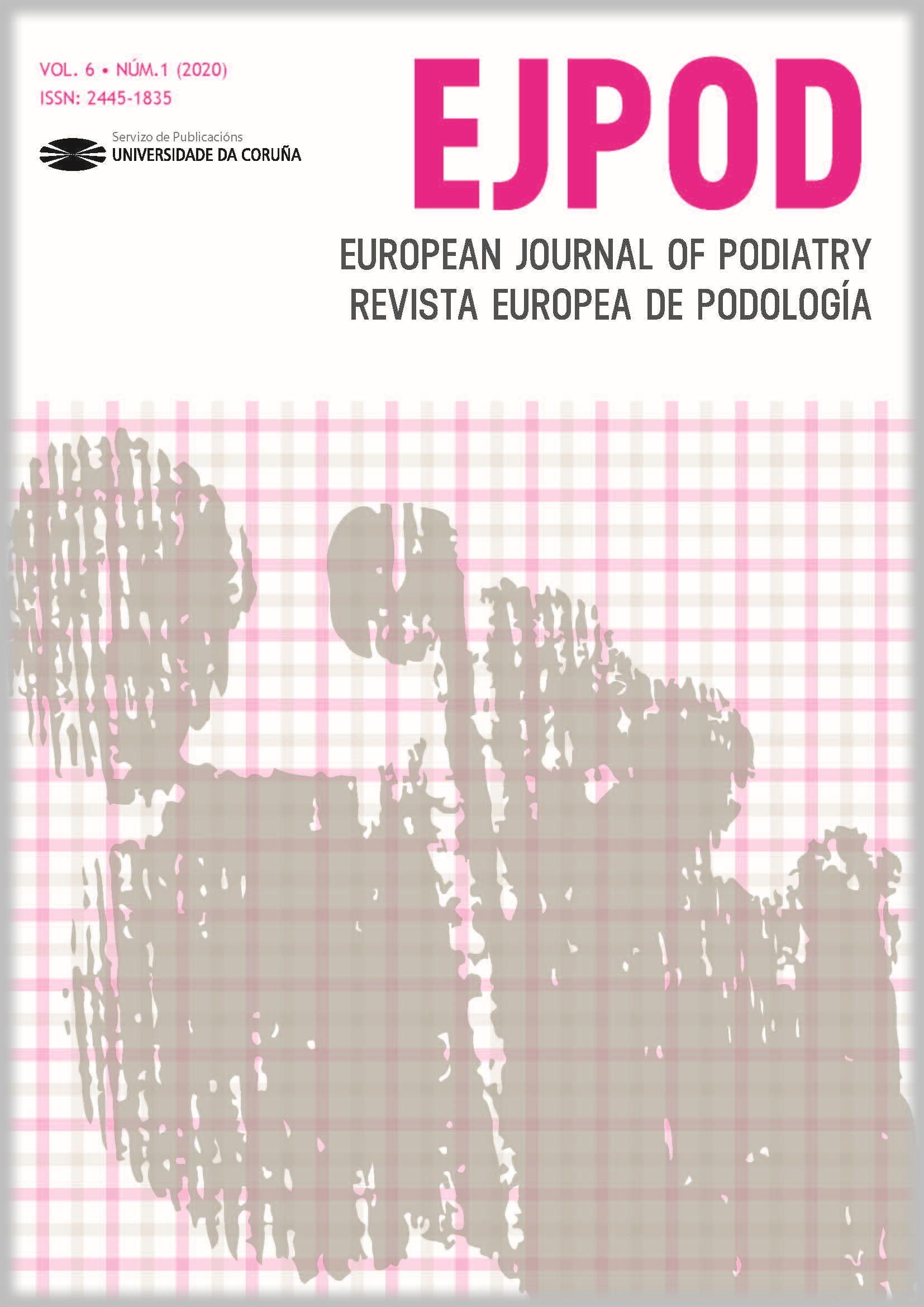Abordaje quirúrgico de la enfermedad de Haglund: revisión bibliográfica
Contenido principal del artículo
Resumen
Objetivos: Conocer cuál de los dos abordajes quirúrgicos presenta menos complicaciones y mejores resultados post-quirúrgicos según las escalas descritas, para el tratamiento de la enfermedad de Haglund: endoscópico o abierto.
Material y métodos: Se consultaron las bases de datos Pubmed, Bucea, Enfispo y Dialnet, desde enero del 2003 hasta 2018, en español y en inglés, bajo los términos siguientes: “Haglund’s deformity”, “treatment Haglund”, “Haglund síndrome”, “Diagnostic Haglund”, "Haglund surgery”, “Calcaneal osteotomy”, “Haglund”.
Resultados: Se incluyeron 33 artículos para la realización de este trabajo, de los cuales 13 eran estudios en los que se mostraba la comparación entre tratamiento quirúrgico abierto y endoscópico en sujetos con deformidad de Haglund. Se incluyeron 393 sujetos de los cuales se intervinieron 415 pies (161 por vía endoscópica y 187 mediante abordaje abierto). 58% de los sujetos tratados por endoscopia calificaron este tratamiento como excelente y las complicaciones reportadas, que fueron menores, sólo estuvieron presentes en 2 individuos, a diferencia de los tratados con cirugía abierta, donde 8 presentaron complicaciones menores y 5 complicaciones mayores.
Conclusiones: El abordaje endoscópico tiene un porcentaje mayor de satisfacción según los resultados post-quirúrgicos obtenidos además de una menor tasa de complicaciones.
Palabras clave:
Descargas
Detalles del artículo
Citas
Haglund P. Beitrag zur Klinik der Achilles tendon. Zeitschr Orthop Chir. 1928:49-48.
Jiménez Martín F, Alonso Valdazo MD, Díaz Peña G, Fernández Leroy J, Hernández Herrero D, Díaz García F. Haglund’s Syndrome. Two Case Reports. Reumatol Clínica (English Ed. 2017;13(1):37-38. doi: https://doi.org/10.1016/j.reumae.2015.12.005
Pavlov H, Heneghan M a, Hersh a, Goldman a B, Vigorita V. The Haglund syndrome: initial and differential diagnosis. Radiology. 1982;144(1):83-88. doi: https://doi.org/10.1148/radiology.144.1.7089270
Reinherz RP, Smith BA, Henning KE. Understanding the pathologic Haglund’s deformity. J Foot Surg. 1990;29(5):432-435.
Biyani A, Jones DA. Results of excision of calcaneal prominence. Acta Orthop Belg. 1993;59(1):45-49.
Le TA, Joseph PM. Common exostectomies of the rearfoot. Clin Podiatr Med Surg. 1991;8(3):601-623.
Ahn JH, Ahn CY, Byun CH, Kim YC. Operative Treatment of Haglund Syndrome With Central Achilles Tendon-Splitting Approach. J Foot Ankle Surg. 2015;54(6):1053-1056. doi: https://doi.org/10.1053/j.jfas.2015.05.002
van Dijk CN, van Sterkenburg MN, Wiegerinck JI, Karlsson J, Maffulli N. Terminology for Achilles tendon related disorders. Knee Surgery, Sport Traumatol Arthrosc. 2011;19(5):835-841. doi: https://doi.org/10.1007/s00167-010-1374-z
Codina Santolaria J, Edo Llobet M, Marín Cop M, de la Rosa Fernández M, di Felice Ardente P. Vía de abordaje posterior en cuatro transaquílea en el síndrome doloroso del retropié: Haglund, pump bump y tendinitis calcificante del tendón de Aquiles. Rev del Pie y Tobillo. 2014;28(1):48-55. doi: https://doi.org/10.1016/S1697-2198(16)30021-0
Vaishya R, Agarwal AK, Azizi AT, Vijay V. Haglund’s Syndrome: A Commonly Seen Mysterious Condition. Cureus. 2016;8(10):e820. doi: https://doi.org/10.7759/cureus.820
10. American College of Foot and Ankle Surgeons. Informe ACFAS sobre la Deformidad de Haglund. 2006 [Internet].
Diab HS. Haglund’s syndrome: Classification system and surgical protocol. Curr Orthop Pract. 2016;27(6):633-637. doi: https://doi.org/10.1097/BCO.0000000000000429
Lowdon A, Bader D, Mowat A. The effect of heel pads on the treatment of Achilles tendinitis: a double blind trial. Am J Sport Med. 1984;12:431-435.
Furia JP. High energy extracorporeal shock wave therapy as a treatment for insertional Achilles tendinopathy. Am J Sport Med. 2006;34:733-740.
McGarvey WC, Palumbo RC, Baxter DE LB. Insertional Achilles tendinosis: surgical treatment through a central tendon splitting approach. Foot Ankle Int. 2002;23:19-25.
Pauker M, Katz K, Yosipovitch Z. Calcaneal osteotomy for Haglund’s disease. J Foot Ankle Surg. 1992;31:558-589.
Jiang Y, Li Y, Tao T, et al. The Double-row suture technique: A better option for the treatment of haglund syndrome. Biomed Res Int. 2016;2016. doi: https://doi.org/10.1155/2016/1895948
Scholten PE, van Dijk CN. Endoscopic Calcaneoplasty. Foot Ankle Clin. 2006;11:439-446.
Kaynak G, Ögüt T, Yontar NS, Botanlioglu H, Can A, Ünlü MC. Endoscopic calcaneoplasty: Five-year results. Acta Orthop Traumatol Turc. 2013;47(4):261-265. doi: https://doi.org/10.3944/AOTT.2013.3003
DeVries JG, Summerhays B, Guehlstorf DW. Surgical Correction of Haglund’s Triad Using Complete Detachment and Reattachment of the Achilles Tendon. J Foot Ankle Surg. 2009;48(4):447-451. doi: https://doi.org/10.1053/j.jfas.2009.03.004
Ögüt T, Yontar NS. Treatment of hindfoot and ankle pathologies with posterior arthroscopic techniques. EFORT Open Rev. 2017;2(5):230-240. doi: https://doi.org/10.1302/2058-5241.2.160055
Wu Z, Hua Y, Li Y, Chen S. Endoscopic treatment of Haglund’s syndrome with a three portal technique. Int Orthop. 2012;36(8):1623-1627. doi: https://doi.org/10.1007/s00264-012-1518-5
Jerosch J, Nasef NM. Endoscopic calcaneoplasty--rationale, surgical technique, and early results: a preliminary report. Knee Surg Sports Traumatol Arthrosc. 2003;11(3):190-195. doi: https://doi.org/10.1007/s00167-003-0365-8
Schunck J, Jerosch J. Operative treatment of Haglund’s syndrome. Basics, indications, procedures, surgical techniques, results and problems. Foot Ankle Surg. 2005;11(3):123-130. doi: https://doi.org/10.1016/j.fas.2005.04.003
Vega J, Baduell A, Malagelada F, Allmendinger J, Dalmau-Pastor M. Endoscopic Achilles Tendon Augmentation With Suture Anchors After Calcaneal Exostectomy in Haglund Syndrome. Foot Ankle Int. 2018:107110071775088. doi: https://doi.org/10.1177/1071100717750888
Natarajan S, Narayanan VL. Haglund Deformity - Surgical Resection by the Lateral Approach. Malaysian Orthop J. 2015;9(1):1-3. doi: https://doi.org/10.5704/MOJ.1503.006
Xia Z, Yew AKS, Zhang TK, Su HCD, Ng YCS, Rikhraj IS. Surgical Correction of Haglund’s Triad Using a Central Tendon-Splitting Approach: A Retrospective Outcomes Study. J Foot Ankle Surg. 2017;56(6):1132-1138. doi: https://doi.org/10.1053/j.jfas.2017.05.015
Kakwani R, Siddique M. Clinical rating systems for the ankle-hindfoot, midfoot, hallux, and lesser toes. Class Pap Orthop. 2014:217-219. doi: https://doi.org/10.1007/978-1-4471-5451-8_53
Iversen JV, Bartels EM, Langberg H. The victorian institute of sports assesment-achilles questionnaire (visa-a)-a reliable tool for measuring achilles tendinopathy. Int J Sports Phys Ther. 2012;7(1):76-84. doi: https://doi.org/10.1007/s40279-013-0096-z
Kersten P, White PJ, Tennant A. Is the pain visual analogue scale linear and responsive to change? An exploration using rasch analysis. PLoS One. 2014;9(6). doi: https://doi.org/10.1371/journal.pone.0099485
Mani SB, Brown HC, Nair P, et al. Validation of the foot and ankle outcome score in adult acquired flatfoot deformity. Foot Ankle Int. 2013;34(8):1140-1146. doi: https://doi.org/10.1177/1071100713483117
Ogilvie-Harris D, Mahomed N, Demazière A. Anterior impigement of the ankle treated by arthroscopic removal of bony spurs. J Bone Jt Surg. 1993;75-B:437-440.


